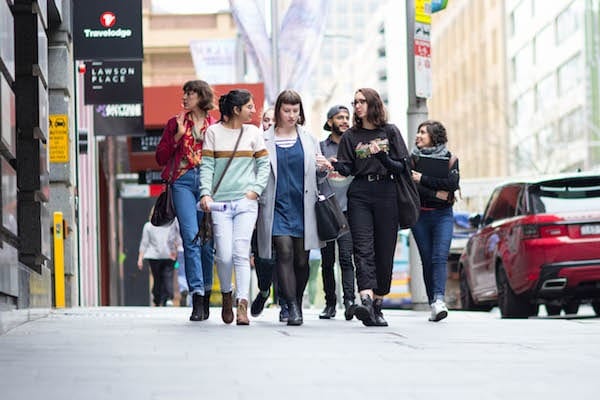When the media and authorities discuss the sexual harassment faced by women and girls in cities many people think that sexual harassment is harmless, ‘flirty small-talk’ and ‘just a bit of fun’ — something we all have to deal with but that doesn’t have a real impact.
A new report, Unsafe in the City, commissioned by Plan International in partnership with researchers at Monash University’s XYX Lab, now gives an alarming new picture of how widespread this harassment is and what women do to deal with and avoid it.
Through the personal stories of over 20,000 young women and girls from cities as diverse as Sydney, Delhi, Madrid, Kampala and Lima we can unequivocally state that unrelenting harassment and abuse is a normalized and expected part of being a young woman and it changes the way we navigate a city.
The Free to Be online map-based tool was co-designed with young women to maximise engagement and create a new space for women and girls to share their often hidden experiences. The social survey asked young women to identify the areas of the city where they felt safe and unsafe, good or bad and – because of the anonymity – offers a brand new method for illuminating stories and issues from those whose voices are not always heard, and for incidents that are very rarely reported.
Over a six-week period, young women mapped and commented on how safe and welcome spaces in the city made them feel. The survey uncovered a range of information including demographics, what time of day places were safe or unsafe, where incidents occurred, how women viewed the discrimination they experienced and whether or not they reported the incident (whether formally or informally).
Across Sydney, Delhi, Madrid, Kampala and Lima the percentage of ‘bad’ spots average around 80% (Table X).
Table X: Total number of pins and ratios
| # Pins* | Good to bad ratio | # comments | Good to bad ratio | ||
| Delhi | 14,876 | 37 : 63 | 4,602 | 30 : 70 | |
| Kampala | 1,253 | 20 : 80 | 1,251 | 20 : 80 | |
| Lima | 2,037 | 11 : 89 | 1,290 | 6 : 94 | |
| Madrid | 951 | 16 : 84 | 670 | 12 : 88 | |
| Sydney | 2,083 | 25 : 75 | 1,479 | 21 : 79 | |
| Total | 21,200 | 22 : 78** | 9,292 | 18 : 82** | |
|
* Total number of pins excluding men, trolls/false pins, and people over the age of 30 years. ** Average across cities |
|||||
The majority of incidents for the bad places in all the cities were recorded as occurring ‘On the street’.
Table X: Activity locations involved in all pin incidents
| PERCENTAGE | DELHI | KAMPALA | LIMA | MADRID | SYDNEY | |||||
| Location | Good | Bad | Good | Bad | Good | Bad | Good | Bad | Good | Bad |
| On the street | 49% | 59% | 67% | 79% | 41% | 64% | 52% | 67% | 44% | 60% |
| Public transport | 32% | 31% | 19% | 19% | 14% | 20% | 21% | 18% | 24% | 20% |
| In a park | 16% | 22% | 3% | 1% | 31% | 8% | 24% | 18% | 33% | 19% |
| At the shops | 12% | 6% | 18% | 13% | 16% | 5% | 14% | 3% | 24% | 10% |
| Out socially | 9% | 6% | 28% | 22% | 15% | 6% | 20% | 6% | 26% | 16% |
| To/from school | 9% | 6% | 19% | 14% | 17% | 11% | 16% | 8% | 14% | 8% |
| To/from work | 7% | 9% | 19% | 25% | 12% | 16% | 15% | 14% | 25% | 20% |
| At public event | 4% | 2% | 7% | 4% | 12% | 3% | 12% | 4% | 11% | 4% |
While ‘On the street’ was the highest tagged location for bad spots, these were often also tagged in conjunction with ‘Public Transport’ and ‘Going to or from school or work’. This reveals starkly that these ‘bad’ experiences directly impact the ability of young women and girls to move around their city.
The comments attached to the pins give nuance and texture to the places and detail what makes a place bad or good. And the outcomes all point to the overwhelming influence of sexual harassment.
Sexual harassment and abuse is constant
In all the cities except Kampala, sexual harassment was dominant in bad spaces. Sexual harassment not involving physical contact included unwanted so-called ‘compliments’ and catcalling, intense staring/leering, surreptitious photography, and propositioning to being verbally threatened with rape, stalked, chased, followed and blocked. Sexual harassment involving physical contact included a ‘pat on the bottom’ through to groping.
“Lots of leering, cat calling and staring from men and teenage boys. One man used to repeatedly ‘serenade’ me with songs about the sexual things he planned to do to me. I did not know him…”
(Age 27, Blacktown)
In both Lima and Madrid, a high 84-85% of the filtered comments made by participants indicated some form of sexual harassment. Here in Australia in Sydney the figure was 72%.
CEO of Plan International Australia Susanne Legena said the consequences of persistent harassment and abuse run deep.
“It’s frightening and draining, and leaves young women feeling completely disempowered. What’s more, by forcing girls and women to constantly adjust their behaviour to stay safe, society is denying them the benefits and opportunities of city life. Their access to work and study opportunities, and their ability to enjoy the city, is restricted.”
In addition to incidents, the physical state of a place had an effect on the perceptions of safety and designations of ‘bad’. Spaces of transit, often crowded or confined, in particular, often provided offenders with opportunities to sexually harass by groping relatively undetected.
“A man on the train, started harassing me on how I looked, asking where I lived where I was going. Told me was heading into the city. Only to follow me off the platform pressing his body against me, chasing me down the station and into the shops. Had to hide in the bathroom for a while, as he was still outside waiting for me.”
(Age 21, Parramatta)
The most common response to bad incidents in all the cities was for the young women and girls who participated to avoid the area when they were on their own. Across all the cities, more than 10% never went back. This creates for each participant in each city a complex personal geography of their city of ‘no-go’ and ‘take-extreme-care’ zones that they must negotiate every day. This defines their engagement with the city in which they live and embeds this discrimination in the city’s geography.
In every city, there were a number of participants who had stopped studying, working or moved (if possible) because of the incident or the level of threat they felt. While not a significant number (between 1 and 2%), that anyone would have their ability to engage with the city compromised to such an extent should concern all of us, especially city authorities.
“I have just left Sydney after 5 years living and studying here. Both love and hate for the city, as a female, especially an Asian female with curves. I never felt safe in this city. I get sexual harassment (catcalling, swears, pervert stares) almost everywhere I go in Sydney. No matter how much I cover myself with hideous clothes, this never stop.”
(Age 28, Fairfield)
Professor of Urban Planning Carolyn Whitzman suggests that all sexual harassment serves as a reminder of young women’s social and physical vulnerability, and therefore has a significant role in increasing the fear of more serious violent attack and thereby controlling and restricting access to the city. The stories gathered in the Free to Be project make this statement real through powerful personal stories that illustrate the everyday impact. This report tells us of the shared concerns of young women and girls in urban environments across five cities, revealing the barriers they face when accessing public spaces that boys and men take for granted.
In the survey, girls and young women made several recommendations that align with the work and research we do at Monash University XYX Lab, including: that girls and young women should be supported to become involved in co-designing their cities; and that governments must adopt and implement laws and policies that address all forms of gender-based violence, including sexual harassment. The overwhelming prevalence of sexual harassment and its impact shown in this report should spur us all – authorities, community and women alike – to build momentum for law, policy and behaviour change to put an end to street harassment so we all feel safer in our cities.
Monash University’s XYX Lab is engaged in local and international research into gender and cites. Dr Nicole Kalms is the founding Director and author of ‘Hypersexual City: The Provoctaion of Soft-Core Urbanism’.






